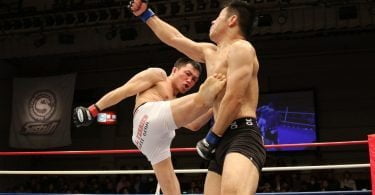It opens with the sound of screaming merging with the thundering rumble of guns. The shadows grow and shift into the flickering pages that tell us we’ve opened the book, as sobs foretell the inevitable misery of the ending. It’s so loud, the sound pushes in on all sides, suffocating you before the page turns, the guns fade – and the play begins.
This is Hemmingway’s A Farewell to Arms, performed by Imitating the Dog. It’s a thoughtful, painful adaption which uses modern techniques to stunning effect.
This is a book within a film within a play – layering the contemporary twists over the words which flicker behind the action. The two lovers are positioned so that on-screen they are always facing each other, ironically moving towards each other even when the stage action forces them in different directions. The camera work is an interesting addition to the performance – it works much more smoothly than you would expect it to, as a narrative tool used to pressurise the action. The images recreate history to engage and resonate with the audience. It replicates the sensation of reading a book in a modern, live-streaming sense.
Claustrophobia
The staging is bleak and bare; the washed out colours, murky corners and smeared windows create a claustrophobic atmosphere. The sound effects are clever, light music melting into the oppressive growl of the guns and back again, over and over so that you never forget them, but even so, each time they start it’s a shock.
Quite a lot of the show is performed in Italian or French, which is a testament to the skill of the company, but the subtitles were a little distracting at times, as we’re sometimes so busy working out what the actors are saying that we miss the emotion and meaning behind the words.
Catherine’s character is probably the most interesting of the play, especially considering that Hemmingway is not known for portrayals of strong female characters. She is neurotic and fragile, a symbol of what the war has turned people into, as are the disheartened, nihilisitic soldiers Frederick fights alongside – they represent the only two possible outcomes for the war – Frederick has no choice but to become like them.
The characters are as invested in the outcome as the audience – they question and argue over the meaning of words and actions – giving the audience a deeper look at the play. It’s an interesting take which works a lot better than I expected it to. The mix of modern and traditional blends perfectly together in the final scene. It’s interesting that the only section not filmed is the Swiss idyll – representing their peace and escape from reality – but the result is that it seems like make-believe; rather than this being a relief from the scripted film they’re playing out, this is just a fantasy and it’s the documentation by the cameras which makes the story real. They seem bored by the fantasy – needing the conflict to fulfil them even if it kills them.
Tension
The childbirth is more painful to watch than any of the war scenes – the music builds agonising tension, getting faster and more panicked until you’re left with nothing but the silence and the sadness and the rain.
Unlike a lot of adaptations this is 99% taken from the novel, sticking as closely as possible to Hemmingway’s style. It isn’t an easy watch; you have to focus and make up your own mind, evaluating the message of the piece yourself. But as a performance it is fantastic, leaving you a little bit breathless, with the frustrated knowledge that no one wins.
Imitating the Dog tour the UK with A Farewell to Arms until 29th November 2014, for tickets visit http://www.imitatingthedog.co.uk/dates/








